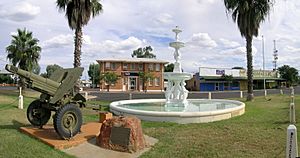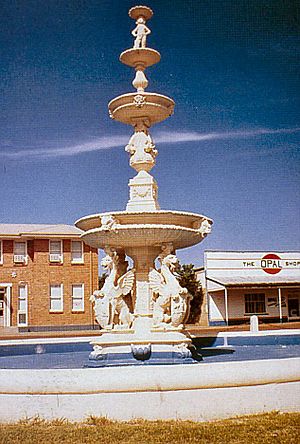Cunnamulla War Memorial Fountain facts for kids
Quick facts for kids Cunnamulla War Memorial Fountain |
|
|---|---|

Cunnamulla War Memorial
|
|
| Location | John Street, Cunnamulla, Shire of Paroo, Queensland, Australia |
| Design period | 1919 - 1930s (interwar period) |
| Built | c. 1924 |
| Official name: Cunnamulla War Memorial Fountain | |
| Type | state heritage (built) |
| Designated | 21 October 1992 |
| Reference no. | 600760 |
| Significant period | c. 1924 - (social) c. 1924 (historical, fabric) |
| Significant components | memorial surrounds/railings, memorial - fountain |
| Lua error in Module:Location_map at line 420: attempt to index field 'wikibase' (a nil value). | |
The Cunnamulla War Memorial Fountain is a special monument in Cunnamulla, Queensland, Australia. It's located on John Street and was built around 1924. This fountain is listed on the Queensland Heritage Register, which means it's an important historical site. It was created to remember the brave soldiers from the area who fought in the First World War.
Contents
Remembering Our Heroes: The Fountain's Story
The Cunnamulla War Memorial Fountain was built to honor soldiers who served in the First World War (1914-1918). This war had a huge impact on Australia. Many soldiers went overseas and sadly, many did not return. War memorials like this fountain became very important. They were a way for communities to show their sadness and respect. They also honored those who served, even if they came home.
Why a Fountain?
The idea for a war memorial fountain in Cunnamulla came about by 1920. However, it took a few years to build. In 1924, a company from Brisbane offered designs. The Paroo Shire Council and the Diggers' Racing Club agreed to build it in 1926.
The design of the Cunnamulla fountain is actually a copy of an old fountain in Rome, Italy. That Roman fountain is believed to be over 400 years old! The Cunnamulla fountain was built by a company called R.C. Ziegler and Son. A photo of the "newly constructed Soldiers Memorial Fountain" appeared in a newspaper in November 1926.
War Memorials in Australia
Before the First World War, Australia didn't have many public monuments. But after the war, communities across the country built memorials. These were often the first national monuments, showing how much the war affected everyone. Many Australian soldiers were buried overseas where they fell. So, these local memorials became like "empty tombs" or cenotaphs. They were sacred places to remember those who couldn't come home.
Australian war memorials are special because they often honor all who served from a town, not just those who died. This shows how much the community was involved in supporting the war effort. In Queensland, statues of a "digger (soldier)" (an Australian soldier) were very popular. But in other states, tall, thin monuments called obelisks were more common.
Fountains were an unusual choice for a main town memorial. They were more often found in school grounds, where they could also be used as drinking fountains. However, water can be a symbol of new life and cleansing. For example, the Australian War Memorial in Canberra has a "Pool of Reflection." In rural Queensland, where water is scarce, a fountain might have been seen as a special "sacrifice" for a memorial.
There used to be a captured gun, or "war trophy", inside the fountain's enclosure. But it was removed at some point.
What Does the Fountain Look Like?
The First World War Memorial fountain is in the middle of a five-way intersection. It forms a traffic island. It has a grassy area around it, enclosed by a low fence with posts and chains.
The memorial is made of concrete. It has a wide, shallow pool at the bottom, about 7 meters (23 feet) across, painted blue inside. On one side, there's a small marble plaque with these words:
Erected by the citizens of Paroo Shire in memory of those gallant Australians who fell in the Great War 1914 - 1918.
The main part of the fountain is a tall, fancy centerpiece. It has four bowls, getting smaller as they go up. The lowest bowl has wavy edges and features heads of gargoyles (carved faces, often grotesque). This bowl is held up by four large winged creatures called griffins. These griffins are holding shields with emus and kangaroos on them. They sit on a base with leaf-like designs.
Above the first bowl is a square stand with carved decorations called festoons (like garlands of flowers or leaves). On top of this is an urn-shaped part with four small winged griffins and swirly designs called scrollwork. This supports the second bowl, which also has wavy edges and gargoyle heads. The fountain continues to rise to a third, simpler bowl. On top of this is a small boy figure. The very top bowl is above the boy's head.
The whole central part of the fountain is very decorated. It has many different designs, including more scrollwork, panels, and leaf patterns.
Why is it a Heritage Site?
The Cunnamulla War Memorial Fountain was added to the Queensland Heritage Register on October 21, 1992. This means it's officially recognized as an important part of Queensland's history and culture.
Showing History
War memorials like this one are important because they show how Queensland's history developed. They represent a common theme across the state: remembering those who served in wars. They also show the strong sense of Australian patriotism and nationalism that was present during and after the First World War. These monuments are a unique record of that time and show what people liked in terms of design between the two World Wars.
A Unique Memorial
War memorial fountains of this size are not common in Queensland. While water is a popular symbol for new life, this fountain is rare because of its unique images and design, which are not found on many other memorials.
Beautiful Landmark
The memorial is also important because it's a beautiful and distinctive landmark. It stands out in the center of a small country town.
Community Connection
Finally, the fountain has a strong and lasting connection with the local community. It reminds them of a major historical event and serves as a central place to remember it.


